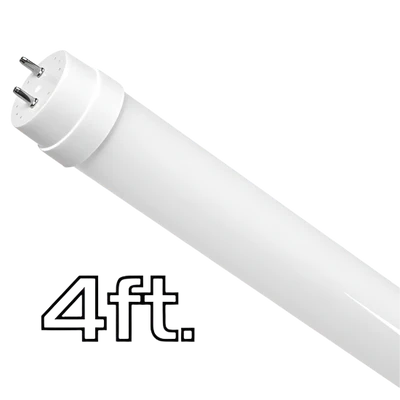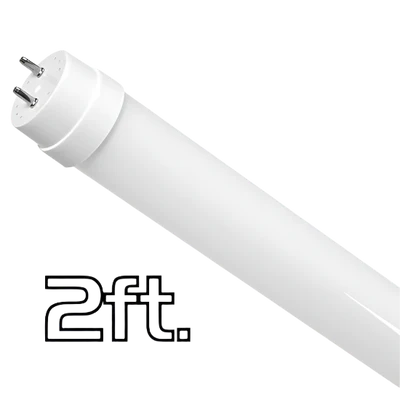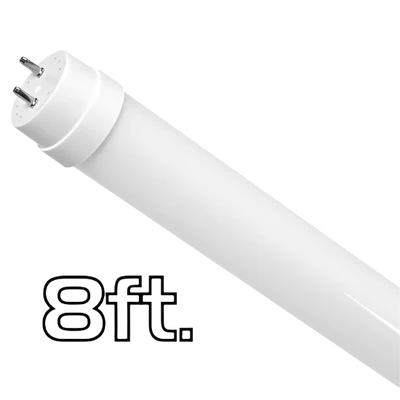Collection: LumeGen LED Tubes
LumeGen LED Tubes
(16)Shop by category below:

LumeGen 4ft. LED Tubes
The go-to replacement for fluorescent tubes, 4ft LED tubes provide energy savings and long-lasting performance.

LumeGen 2ft. LED Tubes
Compact and efficient, 2ft LED tubes offer reliable lighting for small fixtures in commercial and residential settings.

LumeGen 8ft. LED Tubes
8ft LED tubes deliver powerful illumination for warehouses, garages, and large commercial spaces.

LumeGen Other LED Tubes
Find specialty LED tubes, including circlines, U-bends, and unique sizes for various lighting applications.
LumeGen LED Tubes
(16)Shop by category below:

LumeGen 4ft. LED Tubes
The go-to replacement for fluorescent tubes, 4ft LED tubes provide energy savings and long-lasting performance.

LumeGen 2ft. LED Tubes
Compact and efficient, 2ft LED tubes offer reliable lighting for small fixtures in commercial and residential settings.

LumeGen 8ft. LED Tubes
8ft LED tubes deliver powerful illumination for warehouses, garages, and large commercial spaces.

LumeGen Other LED Tubes
Find specialty LED tubes, including circlines, U-bends, and unique sizes for various lighting applications.
- Voltage: AC120-277V
- Dimmable: Dimmable
- Voltage: AC120-277V
- Dimmable: Dimmable
- Voltage: AC120-277V
- Lumens per Watt: 150 lm/W
- Dimmable: Dimmable
- Voltage: AC120-277V
- Lumens per Watt: 130 lm/W
- Dimmable: Dimmable
- Voltage: AC120-277V
- Lumens per Watt: 150 lm/W
- Dimmable: Dimmable
- Voltage: AC120-277V
- Dimmable: Dimmable
- Voltage: AC120-277V
- Lumens per Watt: 150 lm/W
- Dimmable: Dimmable
- Voltage: AC120-277V
- Lumens per Watt: 125 lm/W
- Dimmable: Dimmable
- Voltage: AC120-277V
- Lumens per Watt: 160 lm/w
- Dimmable: Dimmable
- Voltage: AC120-277V
- Dimmable: Dimmable
- Voltage: AC120-277V
- Lumens per Watt: 125 lm/W
- Dimmable: Dimmable
- Voltage: AC120-277V
- Lumens per Watt: 125 lm/W
- Dimmable: Dimmable
- Voltage: AC120-277V
- Lumens per Watt: 130 lm/W
- Dimmable: Dimmable
- Voltage: AC120-277V
- Lumens per Watt: 147 lm/W
- Dimmable: Dimmable
- Voltage: AC120-277V
- Lumens per Watt: 125 lm/W
- Dimmable: Dimmable
- Voltage: AC120-277V
- Lumens per Watt: 127 lm/W
- Dimmable: Dimmable
- Voltage: AC120-277V
- Lumens per Watt: 130 lm/W
- Dimmable: Dimmable
- Voltage: AC120-277V
- Lumens per Watt: 137 lm/W
- Dimmable: Dimmable
- Voltage: AC120-277V
- Lumens per Watt: 137 lm/W
- Dimmable: Dimmable
- Voltage: AC120-277V
- Lumens per Watt: 130 lm/W
- Dimmable: Dimmable
- Voltage: AC120-277V
- Lumens per Watt: 125 lm/W
- Dimmable: Dimmable
- Voltage: AC120-277V
- Lumens per Watt: 130 lm/W
- Dimmable: Dimmable
- Voltage: AC120-277V
- Lumens per Watt: 125 lm/W
- Dimmable: Non-Dimmable
- Voltage: AC120-277V
- Lumens per Watt: 120 lm/W
- Dimmable: Dimmable
- Voltage: AC120-277V
- Lumens per Watt: 125 lm/W
- Dimmable: Dimmable
- Voltage: AC120-277V
- Lumens per Watt: 125 lm/W
- Dimmable: Non-Dimmable
- Voltage: AC120-277V
- Voltage: AC120-277V
|
25 Pack
LumeGen
In Stock
|
SKU: LEDT84F1000050421

LumeGen
SKU: LEDT84F1000050421
Case of 25 - T8 4ft. LED Tube - 16W - 1600 Lumens - Direct Wire - Single Ended Power - LumeGen
|
In Stock |
|||||
|
25 Pack
LumeGen
In Stock
|
SKU: LEDT84F1000050419


LumeGen
SKU: LEDT84F1000050419
Case of 25 - 4ft LED T8 Glass Tube - Type B - 15W - 2200 Lumens - 3500K 4000K 5000K - LumeGen

|
In Stock |
|||||
|
25 Pack
LumeGen
In Stock
|
SKU: LEDT84F1000050418


LumeGen
SKU: LEDT84F1000050418
Case of 25 - 4ft LED T8 Tube - 12W - 1800 Lumens - 3500K 4000K 5000K - LumeGen

|
In Stock |
|||||
|
25 Pack
LumeGen
In Stock
|
SKU: LEDT84F1000050420


LumeGen
SKU: LEDT84F1000050420
Case of 25 - 4ft LED T8 Tube - 17W - 2200 Lumens - 3500K 4000K 5000K - LumeGen

|
In Stock |
|||||
|
25 Pack
LumeGen
In Stock
|
SKU: LEDT84F1000050959


LumeGen
SKU: LEDT84F1000050959
Case of 25 - 4ft LED T8 Glass Tube - Type A+B - 12W - 1800 Lumens - 3500K 4000K 5000K - LumeGen

|
In Stock |
|||||
|
25 Pack
LumeGen
Sold Out
|
SKU: LEDT84F1000050422


LumeGen
SKU: LEDT84F1000050422
Case of 25 - 4ft LED T8 Tube - Type A - 17W - 2200 Lumens - 3500K 4000K 5000K - LumeGen

|
||||||
|
25 Pack
LumeGen
Sold Out
|
SKU: LEDT84F1000050427

LumeGen
SKU: LEDT84F1000050427
Case of 25 - 4ft Color Tunable LED T8 Tube - Type B - 15W - 2200 Lumens - LumeGen
|
||||||
|
25 Pack
LumeGen
Sold Out
|
SKU: LEDT54F1000050744



LumeGen
SKU: LEDT54F1000050744
Case of 25 - 4ft. Color Tunable LED T5 Tube - Type B - 24W - 3120 Lumens - LumeGen


|
||||||
|
25 Pack
LumeGen
In Stock
|
SKU: LEDT84F1000050423


LumeGen
SKU: LEDT84F1000050423
Case of 25 - 4ft LED T8 High Efficiency Tube - Type B - 9.5W - 1600 Lumens - 168 Lumens/Watt - 3500K 4000K 5000K - LumeGen

|
In Stock |
|||||
|
25 Pack
LumeGen
Sold Out
|
SKU: LEDT84F1000050426

LumeGen
SKU: LEDT84F1000050426
Case of 25 - 4ft Color Tunable LED T8 Tube - Type B - 12W - 1800 Lumens - LumeGen
|
||||||
|
25 Pack
LumeGen
In Stock
|
SKU: LEDT54F1000050743



LumeGen
SKU: LEDT54F1000050743
Case of 25 - 4ft. Color Tunable LED T5 Tube - Type B - 15W - 1875 Lumens - LumeGen


|
In Stock |
|||||
|
25 Pack
LumeGen
Sold Out
|
SKU: LEDT84F1000050705

LumeGen
SKU: LEDT84F1000050705
Case of 25 - 4ft LED Universal Tube - Type AB - 18W - Color Tunable 30K/35K/40K/50K/65K - LumeGen
|
||||||
|
2 Pack
LumeGen
Sold Out
|
SKU: LEDT84F1000050761

LumeGen
SKU: LEDT84F1000050761
2-Pack - 4ft. LED Emergency LED Tube - Type B - 15W - 2000 Lumens - Color Tunable 35K/40K/50K - LumeGen
|
||||||
|
25 Pack
LumeGen
Sold Out
|
SKU: LEDT84F1000050704

LumeGen
SKU: LEDT84F1000050704
Case of 25 - 4ft LED Universal Tube - Type AB - 15W - Color Tunable 30K/35K/40K/50K/65K - LumeGen
|
||||||
|
25 Pack
LumeGen
Sold Out
|
SKU: LEDT84F1000050760


LumeGen
SKU: LEDT84F1000050760
Case of 25 - 4ft. Wattage Adjustable & Color Tunable LED T8 Tube - Type B - 12W/15W/18W - 30K/35K/40K/50K/65K - LumeGen

|
||||||
|
LumeGen
In Stock
|
SKU: LEDT82F1000050492


LumeGen
SKU: LEDT82F1000050492
2ft LED T8 Glass Tube - Type B - 9W - 1150 Lumens- 3500K 4000K 5000K - LumeGen

|
In Stock |
|||||
|
25 Pack
LumeGen
In Stock
|
SKU: LEDT82F1000050492-25K


LumeGen
SKU: LEDT82F1000050492-25K
Case of 25 - 2ft LED T8 Glass Tube - Type B - 9W - 1150 Lumens- 3500K 4000K 5000K - LumeGen

|
Available |
|||||
|
2 Pack
LumeGen
Sold Out
|
SKU: LEDT82F1000050702

LumeGen
SKU: LEDT82F1000050702
2-Pack - 2ft LED Universal Tube - Type AB - 8W - Color Tunable 30K/35K/40K/50K/65K - LumeGen
|
||||||
|
40 Pack
LumeGen
Sold Out
|
SKU: LEDT82F1000050702-20PK

LumeGen
SKU: LEDT82F1000050702-20PK
Case of 40 - 2ft LED Tubes - Type AB - 8W - Color Tunable 30K/35K/40K/50K/65K - LumeGen
|
||||||
|
25 Pack
LumeGen
In Stock
|
SKU: LEDT83F1000050423-25PK


LumeGen
SKU: LEDT83F1000050423-25PK
Case of 25 - 3ft LED T8 Tube - Type B - 12W - 1450 Lumens - 3500K/4000K/5000K - LumeGen

|
Available |
|||||
|
30 Pack
LumeGen
Sold Out
|
SKU: LEDT83F1000050703-15PK

LumeGen
SKU: LEDT83F1000050703-15PK
Case of 30 - 3ft LED Universal Tube - Type AB - 12W - Color Tunable 30K/35K/40K/50K/65K - LumeGen (15 2-Packs)
|
||||||
|
10 Pack
LumeGen
In Stock
|
SKU: LEDT8UB1000050700


LumeGen
SKU: LEDT8UB1000050700
Case of 10 - 6in. Color Tunable T8 U-Bend LED Tube - Type A+B - 15W - 35K/40K/50K - LumeGen

|
In Stock |
|||||
|
30 Pack
LumeGen
Sold Out
|
SKU: LEDT818IN1000050701-15PK

LumeGen
SKU: LEDT818IN1000050701-15PK
Case of 30 - 18in. T8 LED Glass Tube - 6W - Type B - 750 Lumens - LumeGen (15 2-Packs)
|
||||||
|
LumeGen
In Stock
|
SKU: LEDT83F1000050423


LumeGen
SKU: LEDT83F1000050423
3ft LED T8 Tube - Type B - 12W - 1450 Lumens - 3500K/4000K/5000K - LumeGen

|
In Stock |
|||||
|
2 Pack
LumeGen
Sold Out
|
SKU: LEDT83F1000050703

LumeGen
SKU: LEDT83F1000050703
2-Pack - 3ft LED Universal Tube - Type AB - 12W - Color Tunable 30K/35K/40K/50K/65K - LumeGen
|
||||||
|
2 Pack
LumeGen
In Stock
|
SKU: LEDT818IN1000050701

LumeGen
SKU: LEDT818IN1000050701
2-Pack - 18in. T8 LED Glass Tube - 6W - Type B - 750 Lumens - LumeGen
|
In Stock |
|||||
|
2 Pack
LumeGen
In Stock
|
SKU: LEDCLT91000050707

LumeGen
SKU: LEDCLT91000050707
2-Pack - 12in. LED T9 Circline Tube Lamp - Universal Type A+B - 16W - 1700 Lumens - Color Selectable - LumeGen
|
In Stock |
|||||
|
2 Pack
LumeGen
In Stock
|
SKU: LEDCLT91000050706

LumeGen
SKU: LEDCLT91000050706
2-Pack - 8in. LED T9 Circline Tube Lamp - Type A+B - 11W - 1200 Lumens - Color Selectable - LumeGen
|
In Stock |
|||||
LumeGen 4ft. LED Tubes
The go-to replacement for fluorescent tubes, 4ft LED tubes provide energy savings and long-lasting performance.
LumeGen 2ft. LED Tubes
Compact and efficient, 2ft LED tubes offer reliable lighting for small fixtures in commercial and residential settings.
LumeGen 8ft. LED Tubes
8ft LED tubes deliver powerful illumination for warehouses, garages, and large commercial spaces.
LumeGen Other LED Tubes
Find specialty LED tubes, including circlines, U-bends, and unique sizes for various lighting applications.
Replace outdated fluorescent tubes with LumeGen LED Tubes for superior efficiency and brighter, more reliable lighting. Our LED tubes fit seamlessly into existing fixtures and provide instant, flicker-free light. They are the perfect solution for upgrading schools, offices, and commercial spaces while reducing your environmental footprint.






























